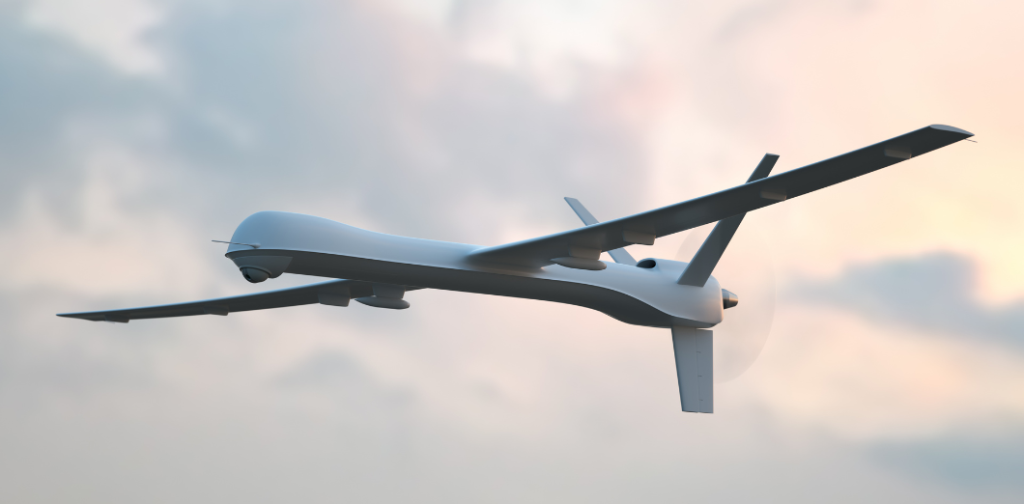Every drone flight is a high-stakes performance test not just for aerodynamics and electronics, but for the materials that hold it all together. Propellers must withstand extreme rotational speeds and dynamic torque, keeping their shape under centrifugal force while resisting deformation from heat and vibration. At the same time, the airframe and structural components experience constant flexing as the drone banks, accelerates, or absorbs the impact of landing.
Add to that the environmental stresses, cold temperatures at high altitude, sudden gusts of wind, solar exposure, and abrasive debris from takeoffs, and it becomes clear that only certain materials are up to the challenge. To keep drones flying reliably, each part must be both incredibly strong and extremely lightweight, offering precision under pressure without compromising durability.
That’s where engineering plastics and advanced composites truly shine. Read on to learn about the ideal materials to use for unmanned aerial vehicles (UAVs) and how they make an impact on performance.


An Expert is just around the corner.
With over 100 years of combined product knowledge and industry experience, we are confident our plastics experts can help you find a solution for your application.
Performance Plastics for Reliable UAVs
Materials such as glass-filled nylon, polycarbonate, carbon fiber-reinforced plastics, and ABS blends provide the stiffness, toughness, and moldability necessary to construct resilient UAVs. They dampen vibration, resist cracking on impact, and allow for fine-tuned part design, all while keeping weight low to preserve flight time and maneuverability.
For drone engineers and manufacturers, selecting the right polymer isn’t just a design choice. It’s a performance safeguard that ensures the vehicle can consistently handle real-world demands.
Airframes That Won’t Weigh You Down
Carbon fiber dominates UAV airframes for its unbeatable stiffness-to-weight ratio. G10, the fiberglass cousin, offers a more cost-effective alternative with excellent impact resistance. Both materials are CNC-ready and ideal for arms, motor mounts, and fuselage plates.
These composites don’t just fly light; they also resist vibration, temperature changes, and hard landings. For high-performance drones, they’re foundational.
Propellers and Body Shells
Drone components must perform reliably under dynamic, high-stress conditions. Propellers rotate at thousands of RPMs, enduring continuous torque, sudden accelerations, and the occasional mid-air impact. Similarly, body shells must shield sensitive electronics such as cameras, sensors, and batteries while minimizing weight and preserving aerodynamic integrity.
Material selection is very important in both cases. Engineers must strike a balance between rigidity and toughness, guaranteeing fatigue resistance, while also prioritizing moldability for complex geometries. To meet these challenges, thermoplastics offer the ideal combination of strength, resilience, and design flexibility.
Common materials used in propeller and housing construction:
- Polycarbonate (PC): For smaller drones or more aggressive flight patterns, polycarbonate propellers provide exceptional impact resistance. Known for its “unbreakable” characteristics, PC performs well in cold weather, absorbs shock during crashes, and stays structurally intact even after hard landings.
- ABS and PC/ABS Blends: These thermoplastics are widely used in molded drone body shells due to their excellent balance of toughness, lightweight properties, and surface finish. ABS is easy to mold into aerodynamic shapes, while PC/ABS offers improved impact resistance and dimensional stability, ideal for protecting internal components from vibration and minor impacts.
These materials provide:
- Vibration Dampening: Both ABS and PC/ABS naturally dampen operational vibration, which helps preserve camera calibration and sensor accuracy during flight. Their mechanical properties also contribute to quieter operation and reduced wear on fasteners or mounting hardware.
- Moldability and Aesthetics: These materials allow for precise injection molding with detailed surface textures or finishes. This not only improves aerodynamic performance but also supports sleek, branded product designs that appeal to both consumer and commercial markets.
Precision in the Details
Plastic shines in the fine points of drone design. Acetal (Delrin®) gears drive gimbals and pan-tilt systems with minimal wear. Meanwhile, UHMW liners and bushings absorb impact and keep moving parts gliding smoothly. Even wiring channels and connector mounts benefit from engineered plastics that can be routed, drilled, and assembled without metal fatigue.
Drones often operate in environments that push materials to their limits. Agricultural models are exposed to fertilizers and UV radiation, while marine drones face salt spray, moisture, and rapid temperature changes. These conditions can quickly degrade unprotected materials, which is why choosing the right plastic components is imperative for long-term performance.
Piedmont Plastics offers durable, outdoor-rated materials designed to withstand these harsh elements:
UV-stabilized polycarbonate for clear, impact-resistant covers and lenses
Moisture-resistant nylon for strong, dimensionally stable structural parts
Corrosion-proof HDPE for housings, enclosures, and contact surfaces
Need Further Insights?
At Piedmont Plastics, we supply advanced plastics and composites that enable UAV designers to build lighter, smarter, and stronger systems. From ABS sheets to acetal rods, we’ll help you choose the best fit for your flight goals.
Contact us for materials that help your drone go the distance!
Create Your Order Today!
Looking for assistance with your order? Contact us at your local Piedmont Plastics branch today for expert guidance, local inventory, and wholesale distribution!
Request A Quote

